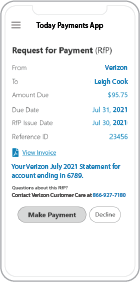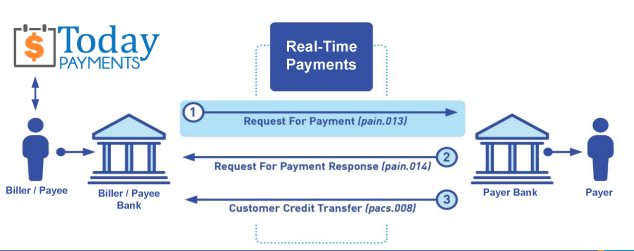
Real-Time Recurring
Using Real-Time Recurring
 Recurring billing is the financial backbone of
many modern businesses—from memberships and subscriptions to
services and B2B contracts. However, traditional recurring payments
often come with delays, failed transactions, and lack of control for
both the business and the customer.
Recurring billing is the financial backbone of
many modern businesses—from memberships and subscriptions to
services and B2B contracts. However, traditional recurring payments
often come with delays, failed transactions, and lack of control for
both the business and the customer.
Real-Time Recurring payments powered by
RTP® (Real-Time Payments) and The FedNow® Service
deliver a smarter, faster solution. With
Request for Payment
(RfP) via digital invoicing, businesses can request
authorization from the Payer in real time. Once approved, funds are
instantly moved from the Payer’s bank to the Payee’s bank,
with full support for static or variable payment amounts.
At TodayPayments.com, we help businesses enable this powerful real-time billing solution—streamlining cash flow, reducing payment friction, and improving the customer experience.
How Real-Time Recurring Works Using RfP
Real-Time Recurring leverages Request for Payment (RfP) to initiate each billing cycle. Here’s how it works:
- The Payee (business) sends a digital invoice or RfP to the Payer (customer)
- The Payer authorizes the transaction using their banking app or portal
- The funds are moved instantly through RTP® or FedNow®, directly to the Payee’s bank account
- The amount can be fixed (static) or change each time (variable)
This payment model empowers customers with more transparency and gives businesses real-time access to recurring revenue.
RTP® and FedNow® Enable Always-On Recurring Payments
Unlike ACH and credit card payments, RTP® and FedNow® enable:
- 24/7/365 settlement, even on weekends and holidays
- Instant confirmation of payment delivery
- Reduced payment failures and reversals
With TodayPayments.com, you can send out recurring RfPs that your customers authorize instantly—improving retention and reducing late payments.
Manage Recurring Payments with Alias-Based Controls
Our system allows you to configure recurring billing profiles by:
- Using cell phone numbers or email addresses as unique aliases for the Payer
- Assigning Merchant Identification Numbers (MIDs) per subscription tier, customer segment, or billing group
- Supporting multiple financial institutions across all 50 states
This level of control ensures every recurring transaction is trackable, secure, and optimized for your operational needs.
Support for All Business Models and Billing Types
Real-Time Recurring works for any business model, including:
- Monthly membership platforms
- Subscription SaaS and digital services
- Professional services with retainer-based billing
- Utilities, telecom, insurance, and more
Whether your billing cycle is weekly, monthly, or dynamic, TodayPayments.com delivers a flexible framework for collecting recurring payments.
Digital Invoicing with ISO 20022-Compliant Messaging
We provide the infrastructure to send Request for Payment (RfP) using secure, ISO 20022-compliant messaging. This enables:
- Branded Hosted Payment Pages embedded in your digital invoices
- Click-to-pay options directly linked to the RfP
- Instant approval and fund movement once the customer authorizes
This simplifies billing operations while giving customers a familiar, seamless payment experience.
Integrated Reconciliation and Real-Time Treasury Visibility
Every Real-Time Recurring payment automatically syncs with our treasury tools and, optionally, with QuickBooks® QBO, providing:
- Real-time reconciliation of recurring transactions
- Aging and history reports per customer or invoice
- Automated matching of payments to digital invoices
This keeps your finance team fully informed and reduces manual overhead.
Attributes of Real-Time Recurring for your business using instant payments
To create a real-time recurring payment system, several attributes must be considered to ensure efficiency, security, and reliability. Here are the key attributes:
1. Frequency: Define the frequency at which payments will recur, such as daily, weekly, monthly, or custom intervals.
2. Amount: Specify the amount of each payment in the recurring series. This can be a fixed amount or variable based on certain conditions.
3. Start Date: Set the start date for the recurring payments. This determines when the payment series will begin.
4. End Date or Duration: Decide whether the recurring payments will have an end date or continue indefinitely. If there is an end date, specify it accordingly. Alternatively, define the duration for which the payments will recur.
5. Authorization: Implement a secure authorization mechanism to ensure that the payer consents to the recurring payments. This may involve obtaining explicit consent through electronic signatures, authentication tokens, or other methods.
6. Payment Method: Determine the preferred payment method for processing the recurring payments. This could include direct debit from a bank account, credit card payments, electronic funds transfer (EFT), or other payment options.
7. Integration with Financial Systems: Integrate the real-time recurring payment system with financial systems, such as accounting software, banking platforms, or payment gateways. This allows for seamless transaction processing and reconciliation.
8. Error Handling: Implement robust error handling mechanisms to address any issues that may arise during payment processing, such as insufficient funds, payment failures, or technical errors. Provide clear instructions for resolving errors and retrying failed payments.
9. Security Measures: Ensure that the real-time recurring payment system adheres to strict security standards to protect sensitive financial information and prevent fraud. This may include encryption, tokenization, multi-factor authentication, and compliance with regulatory requirements.
10. Notification and Confirmation: Provide timely notifications and confirmations to both the payer and payee for each recurring payment transaction. This enhances transparency and allows for tracking and reconciliation of payments.
11. Customer Support: Offer dedicated customer support channels to assist users with setting up, managing, and troubleshooting recurring payments. Provide guidance and assistance as needed to ensure a positive user experience.
By incorporating these attributes into the design and implementation of a real-time recurring payment system, organizations can streamline their payment processes, improve cash flow management, and enhance customer satisfaction.
Creation Recurring Request for Payment
We were years ahead of competitors recognizing the benefits of RequestForPayment.com. We are not a Bank. Our function as a role as an "Accounting System" in Open Banking with Real-TimePayments.com to work with Billers to create the Request for Payment to upload the Biller's Bank online platform. Today Payments' ISO 20022 Payment Initiation (PAIN .013) shows how to implement Create Real-Time Payments Request for Payment File up front delivering a message from the Creditor (Payee) to it's bank. Most banks (FIs) will deliver the message Import and Batch files for their company depositors for both FedNow and Real-Time Payments (RtP). Once uploaded correctly, the Creditor's (Payee's) bank continues through a "Payment Hub", either FedNow or RTP, will be the RtP Hub will be The Clearing House, with messaging to the Debtor's (Payer's) bank.

ACH and both Instant and Real-Time Payments Request for Payment
ISO 20022 XML Message Versions
The versions that
NACHA recommends for the Request for Payment message and the Response to the Request are pain.013 and pain.014
respectively. Version 5 for the RfP messages, which
The Clearing House Real-Time Payments system has implemented, may also be utilized as
there is no material difference in the schemas. Predictability, that the U.S. Federal Reserve, via the
FedNow ® Instant Payments, will also use Request for Payment. The ACH, RTP ® and FedNow ® versions are Credit Push Payments.
Payees ensure the finality of Instant Real-Time
Payments (IRTP) and FedNow using recurring Requests for
Payments (RfP), Payees can implement certain measures:
1.
Confirmation Mechanism:
Implement a confirmation mechanism to ensure that each
payment request is acknowledged and confirmed by the payer
before the payment is initiated. This can include requiring
the payer to provide explicit consent or authorization for
each recurring payment.
2.
Transaction Monitoring:
Continuously monitor the status of recurring payment
requests and transactions in real-time to detect any
anomalies or discrepancies. Promptly investigate and resolve
any issues that arise to ensure the integrity and finality
of payments.
3.
Authentication and
Authorization: Implement strong
authentication and authorization measures to verify the
identity of the payer and ensure that only authorized
payments are processed. This can include multi-factor
authentication, biometric verification, or secure
tokenization techniques.
4.
Payment Reconciliation:
Regularly reconcile payment transactions to ensure that all
authorized payments have been successfully processed and
finalized. This involves comparing transaction records with
payment requests to identify any discrepancies or
unauthorized transactions.
5.
Secure Communication Channels:
Utilize secure communication channels, such as encrypted
messaging protocols or secure APIs, to transmit payment
requests and transaction data between the payee and the
payer. This helps prevent unauthorized access or
interception of sensitive payment information.
6.
Compliance with Regulatory
Standards: Ensure compliance with
relevant regulatory standards and guidelines governing
instant payments and recurring payment transactions. This
includes adhering to data security requirements, fraud
prevention measures, and consumer protection regulations.
By implementing these measures, Payees can enhance
the finality and security of Instant Real-Time Payments
using recurring Requests for Payments, thereby minimizing
the risk of payment disputes, fraud, or unauthorized
transactions.
Each day, thousands of businesses around the country are turning their transactions into profit with real-time payment solutions like ours.

Contact Us for Request For Payment payment processing

